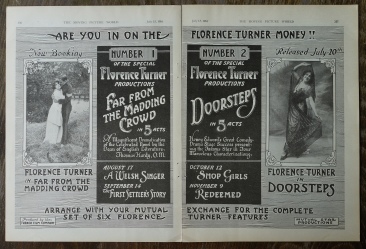
Advertising for Far From the Madding Crowd, Moving Picture World, July 15 1916. Many thanks to the Townly Cooke Collection for the picture.
For me, there are few things more tantalising than stumbling across an old theatre programme for a play that closed many years back, or reading about a film that was made a century ago but has not survived. You might know who the players were, the parts they took, even what they wore, but the chance to see what was performed is long gone.
For people who love silent film – and, in particular, British silent film – glimpses of performances past both frustrate and enthuse. It is estimated that 80% of British silents are lost – you come across a reference in a book or magazine, perhaps see still photographs or find musical cue sheets, read a contemporary review or see an advertisement – but you can’t watch the film itself. The missing reels are constantly out of reach.
I’m seeking information about the lost British silent Far from the Madding Crowd (1915). I came across it by chance when researching a fine (extant) film, East Is East (1916), directed by Henry Edwards, who also played in the film. Edwards went on to become one of the big stars of British cinema, and can be seen looking back over his career in this delightful British Pathé film.
East is East featured the very talented actor, director, writer and producer Florence Turner. I was intrigued to learn that this was not the first pairing of Edwards and Turner; the previous year they had both appeared in a version of Far from the Madding Crowd, directed by Turner’s friend and business partner Larry Trimble.
Edwards played Gabriel Oak and Turner was Bathsheba Everdene. Malcolm Cherry played Farmer Boldwood and Campbell Gullan was Sargeant Troy. So what did this Far from the Madding Crowd look like? Where was it filmed? How did the actors play their parts?
Well, if their pairing in East is East is any indication, Turner and Edwards would have played well together as Bathsheba and Oak in a well-received “quality” picture based on a respected novel (and if you don’t know the plot, please note that the following contemporary reviews contain spoilers).
The Hull Daily Mail on 28 February 1916 said: “The mere fact that so great a novel as Far from the Madding Crowd by so skilled an author as Thomas Hardy should be produced as a picture play is of sufficient importance to warrant the keenest interest of the public. Far from the Madding Crowd is the life story of an impulsive, capricious, but fascinating woman upon whom tragedy and suffering is brought by her own actions. Her innate inability to refrain from misleading and torturing those whom she captivated by her alluring ways was the cause of the heartbreaking of Gabriel, of the death of Troy, and of the final doom of the morbid Boldwood. But, at the end of it all, the happiness of rest and peace must have been intensified by the turmoil that had gone before. The part of Bathsheba is taken by that favourite and appealing cinema actress, Florence Turner. It is refreshing to have brought to the memory the scenes of Wessex country life; and some of the pictures of farm life are if intense interest because they are so realistic.”
On 29 February 1916, the Manchester Evening News reported: “Film versions of popular novels will always be welcome if they are so well done as Hardy’s Far from the Madding Crowd. The picture has many gripping moments as well as scenic and sylvan beauties, and Florence Turner acts the leading part with distinction.” The Rochdale Observer, on 30 August 1916, reported that the film was a “particularly fine production. The setting was admirable and the natural beauty of the scenes depicted added much to the attractiveness of the film. The career of a wandering shepherd and his mistress was followed with much interest.”
I also know a little about which elements of the source novel were filmed. On 3 March 1916 the Hull Daily Mail reported on the strongest scenes: “Great flocks of sheep on the Downs, the catastrophe to Gabriel’s herd, his fall in the world, the saving of the hayrick in the lightning storm while Troy and the others are in drunken sleep, and the unhappy two loves of Bathsheba Everdene.”
Again, courtesy of the Hull Daily Mail (17 November 1915), I learned that “there are several moments of real dramatic intensity in this film. One incident stands out, however, from all the rest – that of the moment when Bathsheba, gazing into the coffin of Fanny Robin, discovers the overwhelming proof of her husband’s misconduct – an episode powerfully acted by Mr Gullan and Miss Turner.”
What I don’t know is whether my favourite scene – Hiving the Bees – was included. But just in case it wasn’t, I’ve been sewing some of the text of that beekeeping scene for my next quilt project.
And I’ve got a pile of Pictures and the Picturegoer magazines from 1916 to hunt through for more clues about this intriguing lost Far from the Madding Crowd.






Love the way you stitch together film history and fabric – it’s fascinating, thanks Lucie!